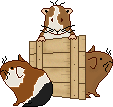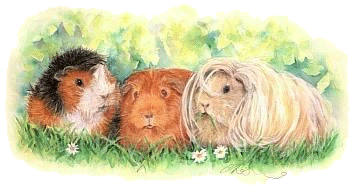 What is a guinea pig?
What is a guinea pig?
A guinea pig is a rodent, and it has a chubby, compact build.
It is 22-35 cm long. Females (sows) weigh 600-1100 gram, males
(boars) 900-1800 gram.
They have a very short neck and no visible tail, although they
do have tailvertebrae.
A guinea pig is a digitigrade, on the forefeet it has 4, on the
hind-feet 3 toes.
There are different kinds of guinea pigs: short-haired, long-haired
(fur of 15 cm or longer) and bristle-haired (the hairs are pointing
all directions).
The guinea pig has in the upper- and lowerjaw 2 gnaw- or cutting-teeth.
The cutting-tooth are growing constantly and to prevent them from
getting too long the cavy has to gnaw a lot.
The guinea pig has little small, bold ears and can hear very very
well.
 Where does the guinea pig come from?
Where does the guinea pig come from?
Our tame cavy is descended from the wild breeds in South- and
Central America. Long before the discovery of America the Indians
of South America kept guinea pigs as pets.
When and how the tame piggies got to the Indians in Panama, will
always be a secret.
About 1540, tame guinea pigs had to have come to Europe, because
a Swiss zoologist (Konrad Gessner) had described the animals already
in 1554.
But, legend has it that about 1670 guinea pigs came to the Netherlands
from Surinam. It was the Dutch buying-men who saw those funny,
friendly little animals by the Indians of Guyana, and took them
home as a pet for their children to play with in Holland. The
guinea pigs withstood the long journey on sea very well, and felt
comfortable in their new environment shortly (and multiplied fast!!).
In 1680 in Holland guinea pigs were bred and sold in France and
England.
 The name: guinea pig or cavy:
The name: guinea pig or cavy:
In Germany they are called: Meerschweinchen. The animals came
to this country from over the sea (in German: Meer), besides they
grunted like pigs and their round shape and way of walking resembled
a lot little piglets (schweinchen=little pig).
In English they are called: Guinea pig. The guinea was a golden
English coin from that time. The first guinea pigs who came from
Holland to England were very expensive, one guinea, that was 21
shillings, a bit more than 1 pound. Guinea-pig would mean something
like: the piglet that cost one guinea.
Later the name guinea-pig was used in the meaning of laboratory
animal, because soon all over the world the guinea pigs were being
used in science to experiment on.
In French they are called: Cobayes and cochon d'Inde, which means
little pig from India.
In Spanish they are called: Conegillo de Indias, which means little
rabbit from India.
(When the westcoast of America was discovered by the Spanish they
thought it was the westcoast of India!)
 What does the guinea pig eat?
What does the guinea pig eat?
The guinea pig is a vegetarian. It does not make high demands
for it's nourishment. If the guinea pig gets fresh feed and grain-fodder
regularly, that is sufficient.
Fresh feed: all kinds of grass, fruits, vegetables, carrots (in
the summer weeds from the garden).
Dry feed: hay (very nice to hide in too!)
Grain-fodder: wheat, oats, maize, peanuts, sunflowerseeds. All
this is ready on hand for sale at the shops.
The guinea pig may not have too much feed, otherwise he will be
too fat and become ill.
Vegetables 40-70 gram, grain-fodder 1-2 tablespoons a day.
Hay however as much as he wants.
A guinea pig does not drink much, but needs water anyway. A bottle
that you can hang in its cage is handy, the water stays clean
that way.
 Providing:
Providing:
Clean his cage regularly.
A lot of playing and cuddling (if there are kids in the house
that should not be a problem!)
When the cutting-teeth get too long, as a result of the fact the
cavy could not gnaw enough, they could grow over each other. The
guinea pig cannot eat anymore. The vet has to shorten the teeth.
Too long nails: You can cut the nails with a sharp pair of nail
tongs. Watch the blood vessels. You can see those very clearly
at light-colored feet, but with darker feet that is a little harder,
one should cut those nails not too short.
Flea, louse and mites: This does not happen very often, although
a guinea pig can have catflea. Also piggies that are outside a
lot can get vermin. There are powders and other stuff for sale
at the petshop to resist this.
 Other points:
Other points:
A guinea pig can distinguish colors very well.
Also the hearing is very good, especially the high tones can be
perceived at a level much higher than humans can (the sound of
the door of the refrigerator, where the carrots are, is something
they recognize very well!).
A guinea pig can smell fragrances that are 100-1000 times weaker
than we can smell.
The guinea pig loves to play and needs much more attention than
just a clean cage, food and a caress now and then.

Back to:
the Guinea Pig Hutch
index
HOME


Welcomesign and pictures of Peanut,
Popcorn and Punkie made by me.




we support WWF

 June 2006 June 2006



|
|
|